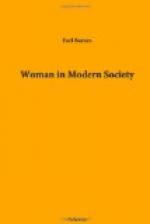The universities, colleges and technical schools, which are massed together in our government reports, had hardly any women students in 1870; in 1880, 19.3% of the students were women; in 1890, 27%; in 1910, 30.4%. In all these institutions we had enrolled in 1910, 17,707 women. Of 602 institutions reported in 1910, 142 were for men only; 108 were for women only; and 352 were open to both sexes. But here again the influence of women increases during each of the four years for, as we have seen, the women took 41.1% of the A.B. degrees granted in 1910. It is surely not too much to say that, if present conditions continue, women will soon be in an overwhelming majority in all secondary and higher education in the United States.
If we examine the teaching force, we find this monopoly already established. In 1870, when our government records begin, 59% of the teachers were women; in 1880, 57.2% were women; in 1890, 65.5%; in 1900, 70.1%; in 1910, 78.6%. The more settled and intelligent the community the more rapid this advance has been. Thus Arkansas has 52.4% women teachers; but Massachusetts has 91.1% and Connecticut has 93%.
In cities, too, the women fill nearly all teaching positions. New York City has 89% women in its force; Boston, 89%; Philadelphia, 91.4%; Chicago, 93.3%. In many cities the proportion is even greater than this: Omaha has 97%; Wheeling, W. Va., 97.5%; Charleston, S.C., 99.3%; and in forty-six American towns of 4,000 to 8,000 inhabitants there is no man teaching. When we remember that many of the men indicated above are in high schools or in supervising posts, we are prepared for the statement in a report recently laid before the Board of Education of New York City that in half the cities of the United States there are virtually no men teaching.
In our high schools, 54% of the teachers are women; in public normal schools, 65%; and in institutions of higher learning 17.6% are women. Even in supervising positions, there are more women than men in the large centers of population. Certainly these figures justify us in saying that women have established a monopoly of education in the United States, except in the higher institutions.
In order to discuss the effects which this monopoly of education by women is having on the curriculum of the schools we must first agree on what constitutes the peculiarity of women’s minds as compared with men’s minds.[29] In our first chapter, it was asserted that women are more interested in the concrete, human, personal, conserving and emotional aspects of life; while men more easily turn to the abstract, material, impersonal, creative and rational aspects. To put it broadly, women are more interested in the humanities; men more readily pursue the sciences. Let us admit at once that there are many individual exceptions to this statement. Some women have reached great excellence in abstract studies; and some men are notoriously concrete and emotional; but nevertheless the general statement seems borne out by a wealth of common observations and detailed comparisons.




